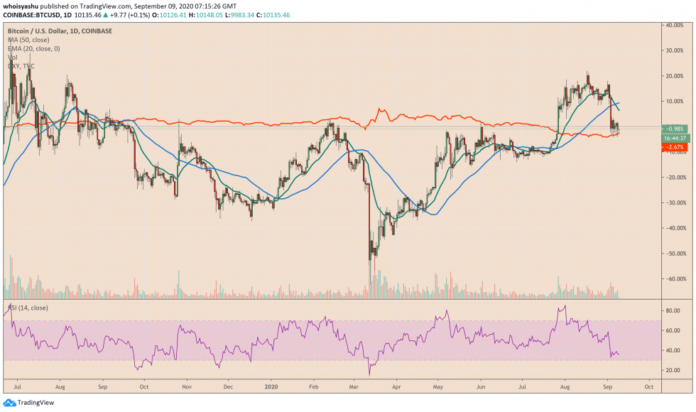
If a stronger US dollar indeed points to a weaker Bitcoin, then the cryptocurrency is facing a humongous bearish bias ahead.
An analysis published by Seeking Alpha’s Robert Balan expects the US dollar to extend its recovery until the second quarter of 2021. That poses troubles for Bitcoin, a cryptocurrency that has developed an uncanny inverse correlation with the US dollar.
Its price earlier surged by more than 200 percent as the greenback plunged to its 27-month low. Nevertheless, a rebound in the US dollar index (Symbol: DXY) flipped the short-term bias, causing Bitcoin to shed about 20 percent of its gains within a week of trading.
Bitcoin and the US dollar has almost moved inversely since March 2020. Source: TradingView.com
US Capital Account
Many analysts believe that the dollar is undergoing an interim upside correction. But as long as the Federal Reserve keeps injecting fresh liquidity to aid the US economy through the aftermath of the COVID-19 pandemic, the long-term outlook for the greenback will remain bearish – and make Bitcoin stronger.
But Mr. Balan thinks otherwise. One of the primary reasons why he is bullish on the dollar is the US Capital Account, a barometer to measure capital inflows versus outflows in the US economy.
The analyst highlighted a sharp improvement in the US Capital Account balance between Q4 2018 to Q4 2019. He noted that a higher capital inflow starts growing on the local currency–typically–after 5-6 finance quarters. That means the US dollar may keep recovering until Q2/2021 (which is terrible for Bitcoin).
“We suggest that the next bout of continuing strength in the US dollar will come from the steady improvement of the US Capital Account Balance during the period from Q4 2018 to Q4 2019,” Mr. Balan wrote.
A surplus Capital Account balance indicates that more people are buying the US dollar and the assets it denominates (such as real estates). It also shows a slowdown in resident capital outflows. Meanwhile, a deficit Capital Account means that more liquidity is moving out of the Capital Account to seek opportunities in foreign markets.
Bitcoin and US 10-year Yields
Bitcoin bulls are counting on a weaker dollar to drive the cryptocurrency’s price higher towards $20,000 by the end of this year. The sentiment grew stronger after the Federal Reserve committed to continue its open-ended stimulus program and lower interest rates policy until required.
March dump vs current dump. Remember when many were expecting “One more leg down to buy back in”.
Reminds me of “One more leg down to fill futures gap.”
Back then we didn’t have:
Companies with $250M BTC
QE Infinity
FED seeking inflation
One more leg down…
#Fiat
#Bitcoin pic.twitter.com/JTemKIrDud
— Alex Saunders
(@AlexSaundersAU) September 8, 2020
A prospect of lower yields reduced appeal for the safest haven assets, including the US dollar and government bonds. As a result, investors started reallocating their capital to riskier assets, benefiting US stocks, gold, and even Bitcoin.
But the recent growth in the US manufacturing and services sector allowed investors to interpret a US economic recovery. That translated into a stronger dollar and a rise in yields of the benchmark US 10-year Treasury bond. Mr. Balan said the long-term bond market might keep shedding out better gains in the coming sessions.
It is due to the Treasury Cash Balance, a barometer to measure the changes in systemic liquidity. Like the US Capital Account, the Cash Balance is also cranking out massive inflows.
“We expect that trend in liquidity inflows to persist until the end of the year. Therefore, yields and the DXY should rise from here, correspondingly.”
That–again–puts Bitcoin under the risks of facing further downside corrections.

Bitcoinist.com is author of this content, TheBitcoinNews.com is is not responsible for the content of external sites.
Our Social Networks: Facebook Instagram Pinterest Reddit Telegram Twitter Youtube












